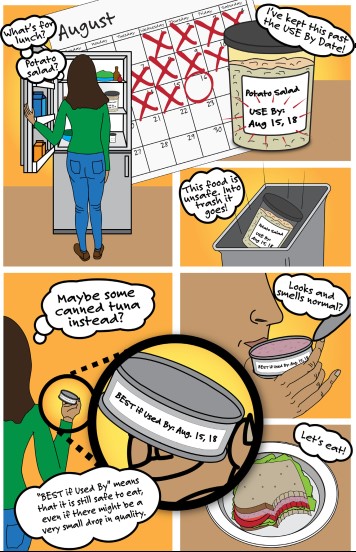There is a lot of food wasted in the US. Leaving aside the items with mold or an “off-smell,” there are the cosmetic issues. We use those “expiration” dates on the labels to guide our decisions, assuming we understand them – except a new study shows that this may not be the case.
A voluntary system of food dating was instituted in 2017. “Use by” is found on a small number of foods susceptible to bacterial contamination (e.g., Listeria) that are eaten without cooking that might mitigate the contamination, think deli. “Best if used by,” on the other hand, refers to the day a food begins to slide off its quality peak and may look, taste, or smell a bit different than usual. More often than not, except for Listeria, food looks, tastes, and smells funny before it becomes lethal.
An initial survey done in 2018 found that 88% of us thought the label definitions were clear. This more recent survey takes a closer look. About 2,600 participants answered online questions, using Amazon Mechanical Turk, about how much attention they paid to food safety, asked whether they knew what those two labels meant, in terms of safety or quality, generally and specifically. They were also shown various messaging about those labels that emphasize quality, safety, financial savings, and food waste. Respondents were age 18 or older and received $2.75 for their twenty minutes in completing the survey.
- 48.2% paid very close attention to food safety, 98% or more of us check date labels at least once in a while.
- Few of us, 22.4%, were aware that federal regulations for food dates did not apply to all foods. [1]
- 92% “knew” what “Best if Used by” meant, except 36% thought it was about safety, and 54% didn’t know the specifics.
- 89% “knew” what “Use by” meant, except 54% thought it was about quality, and 76% didn’t know the specifics.
This is a real-world example of the Dunning-Kruger Effect – where you don’t know what you don’t know. As the researchers write, “not only do consumers frequently misinterpret the new labels, but they often do so with confidence.”
 Each of the messages designed to explain the date labels' actual meanings did improve understanding, none better than another. Framing the information within a story was considered the most effective by the participants. Even so, with their newly found education, only 80% still were correct in understanding the information the dates were meant to relay.
Each of the messages designed to explain the date labels' actual meanings did improve understanding, none better than another. Framing the information within a story was considered the most effective by the participants. Even so, with their newly found education, only 80% still were correct in understanding the information the dates were meant to relay.
Perhaps we should switch the “Use by” label to “Throw out after” and “Best if used by” to “Eat if you dare after.”
[1] I didn’t know, did you? It is required only on infant formula.
Source: Impact of Messaging Strategy on Consumer Understanding of Food Date Labels Journal of Nutrition Education and Behavior DOI:10.1016/j.jneb.2021.03.007




